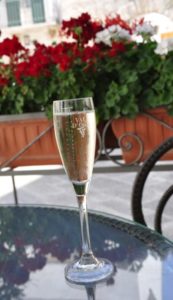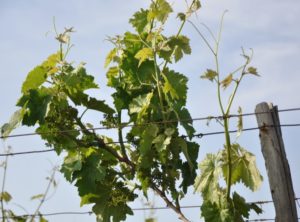Puglia wine dates back to Phoenician times and the Greeks named Puglia ‘Enotria‘, Wineland. Today Puglia is the largest producer of wine in Italy. Often referred to as ‘the wine cellar of Europe’ because in the past it primarily produced wine to send to the rest of Italy and Europe for structure and alcohol content in blending. However over the last decade, Puglia wineries have made investments that are starting to pay off. They realized making quality wine and bottling it for sale could be more profitable in the long run than producing large quantities for blending. The results I tasted were fantastic!
Red wine is king here (rosso) but you’ll also find white (bianco) and rosé (rosato). The rosato was my biggest surprise and some of the best rosé I’ve ever had!! As the climate here is very warm and the sun extremely strong, the grapes produce a wine high in sugar thus strong in flavor and high in alcohol. The grapes are grown in three ways: pergola (overhead canopy which I saw most often), bush (bushes on the ground) and cordon-trained (traditional vines on lines). The vineyard yields are quite high, about four to five times that of other regions.
Grape Varieties
The native grape varieties grown here were very new to me.
*Â Red
- Primitivo:Â This is the king of Puglia’s grapes and its name comes from the early ripening of the grape. A clone of the Zinfandel grape, its the heavily ‘exported’ grape for its structure. The wine it produces is an intense violet color with scents of currants, berry and spice and a soft, velvety fruit taste.
- Negroamaro: Meaning ‘bitter black’, this grape makes a strong wine with minimum 13% alcohol and no less than 2 years of aging. The wine it produces is dark red in color with a scent of cherry, leather and pepper and a taste that’s warm and powerful.
- Nero di Troia: Also know as Uva di Troia, this grape is said to have been brought to Puglia from Troy by the Greeks 2,000 years ago. It produces a deep red wine with fruity and spicy notes.
- You’ll also find Aleatico di Apulia (used for sweet dessert wine), Malvasia Nera, Montepulciano and Cabarnet grapes.
* White
- Bombino Bianco: This grape also comes in red, Bombino Nero, often used for rosés. As a white its crisp and fresh, golden in color with a scent of ripe fruits.
- Malvasia Bianca: It produces an elegant well balanced wine with a scent of iris, pineapple and vanilla.
- You’ll also find Verdeca, Bianco d’Alessano, Fiano, Chardonnay and Sauvignon grapes.
 DOC & IGT
DOC & IGT
There are 26 DOC (denomination d’origine controllata) in Puglia and only 10% of the wines in the region have this designation. Other wines from the region are either IGT (typical geographic indication) or Vini da Tavola (table wine).
- DOC: Salice Salento is the most famous region with the highest concentration of quality wine produced. Reds are mostly Negroamaro grape and wines from this region can only use the local grapes. Whites are mostly Malvasia Bianca. Other widely known DOC are Castel del Monte (Nero di Troia is the dominant grape), Brindisi (Negroamaro), Manduria (Primitivo) and Gioia del Colle (Primitivo).
- IGT: Six total designations include Puglia, Daunia, Murgia, Valle d’Itria, Tarantino and Salento.
For a great interactive map on Puglia’s wine regions visit Movimento Turismo del Vino Puglia.
Favorites
 My favorite wines out of the many DOC and IGT I tasted on our trip were from the following wineries…
My favorite wines out of the many DOC and IGT I tasted on our trip were from the following wineries…
- Leone de Castris: Near Lecce, one of the most award wining wineries in Puglia. They’ve been in the wine business since 1665 and started bottling in 1925. We had a bottle of Salice Salento Riserva Red DOC 2007 made of 90% Negroamaro and 10% Malvasia Nera. With a fruity smell of blackberry, black cherry and sweet spices, its smooth berry taste is very well balanced.
- Tenute Rubino: Located in Brindisi, they produce red, white and rosé wines including my FAVORITE rosé of the trip.
- Cantina del Locorotondo: We had a great visit to the Cantina and tasted 10 of their 21 wines. We brought home a bottle of two favorites, Cummerse Rosé (100% Pinot Nero IGT Puglia, crisp, refreshing and a light fruit taste) and Casale San Giorgio (Negroamaro and Primitivo IGT Puglia, a nice round and curvy red). Although we didn’t try Locorotondo’s specialty sparkling, we brought home a bottle of Locorotondo DOC PrimoSecco (60% Verdeca, 35% Biaco d’Alessano, 5% Fiano).


